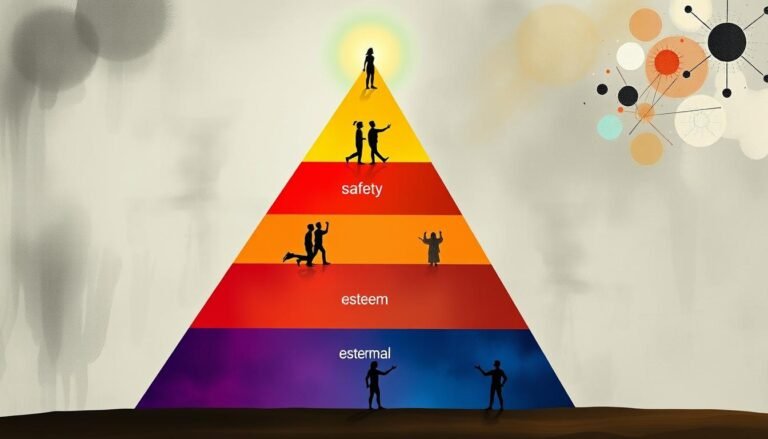Setting SMART Goals: Your Path to Success
What if the secret to success isn’t about working harder but smarter? Many dream of success but can’t make it happen. That’s where SMART Goals come in. This method turns vague dreams into clear, achievable goals. It helps with both personal and professional growth.
By focusing on Specific, Measurable, Achievable, Relevant, and Time-bound goals, you can make your dreams real. This approach boosts your chances of success a lot.
This article shows how SMART Goals bring clarity to goal setting. It boosts motivation and keeps you focused on your goals. Are you ready to see how effective goal setting can lead you to success?
Key Takeaways
- SMART goals are a practical approach to setting achievable objectives.
- Specific goals can increase achievement likelihood by 50%.
- Time-bound goals foster urgency, leading to prompt action.
- Relevant goals align with personal aspirations, enhancing motivation.
- Breaking down goals improves attainment rates by 60%.
- Measurable goals help track progress and maintain momentum.
Understanding the Importance of Goal Setting
Setting goals is key to growing personally and professionally. It gives people a clear path to their goals. This clarity helps with motivation and staying on track.
Defining Goals for Personal and Professional Growth
Having clear goals is essential for reaching life and work dreams. Using the SMART Goals framework helps make goals specific, measurable, achievable, realistic, and time-bound. This makes sure goals are clear and help with personal and professional growth.
The Role of SMART Goals in Structuring Goals
The SMART Goals framework is a great way to set goals. It helps set goals that are challenging yet realistic. Specific goals make expectations clear, and measurable goals let you track progress.
Setting achievable goals keeps you motivated and moving forward. Goals should match your personal goals and be flexible. Having a deadline helps set milestones for success.
| SMART Criteria | Importance |
|---|---|
| Specific | Provides clarity and focus, making it easier to understand what is needed to achieve the goal. |
| Measurable | Allows individuals to track progress and evaluate success along the way. |
| Achievable | Ensures goals are realistic, which helps in maintaining motivation and pursuit. |
| Relevant | Aligns with broader ambitions and adapts to evolving needs, promoting continued relevance. |
| Time-Bound | Creates urgency through deadlines, enhancing the commitment to goal achievement. |
The Components of SMART Goals
Understanding SMART Goals is key for achieving goals well. Each part plays a big role in making a plan that helps you succeed. By using these parts, you can set goals that are clear, measurable, doable, match your big goals, and have a deadline.
Specific: The Power of Precision
Specific goals clear up confusion by setting out exactly what you want to do. They make it clear who is doing what, what steps to take, and the details. For example, instead of saying “get fit”, a specific goal might be “lose 10 pounds in 3 months by exercising and eating right”. This makes sure everyone knows what the goal is.
Measurable: Tracking Progress Mile by Mile
Measurable goals let you see how well you’re doing and know when you’ve reached your goal. This keeps you motivated. For businesses, a goal like “increase sales by 10% in the next quarter with a marketing campaign” sets a clear target. It also lets you adjust if needed.
Achievable: Balancing Ambition and Reality
Goals should be realistic to avoid feeling stuck or losing motivation. Achievable goals consider what you can do with what you have. For instance, aiming to boost employee productivity by 20% in six months must think about current work and resources. Finding the right balance between dreams and reality is key for staying motivated and effective.
Relevant: Aligning with Your Bigger Picture
Relevant goals make sure each aim fits with your main goals. A goal like making an app to help your business must help your business grow. This focus saves time and makes sure you’re working on what’s important.
Time-Bound: Creating a Sense of Urgency
Time-bound goals make you act fast and focus your efforts. Deadlines help teams and individuals work better together. For example, “do market research and launch a new product in three months” sets a deadline. Deadlines keep everyone on track and build momentum.
| SMART Goal Component | Description | Example |
|---|---|---|
| Specific | Clearly defines the goal without ambiguity | “Lose 10 pounds in 3 months.” |
| Measurable | Tracks progress and determines achievement | “Increase sales by 10% in the next quarter.” |
| Achievable | Realistic and attainable based on resources | “Improve productivity by 20% in six months.” |
| Relevant | Aligns with larger objectives and purpose | “Develop an app to enhance business growth.” |
| Time-Bound | Assigns deadlines for goal completion | “Launch new product in six months.” |
SMART Goals: A Practical Framework for Success
Crafting SMART Goals turns vague ideas into clear, actionable plans. George T. Doran introduced the SMART framework in 1981. It makes sure goals are specific, measurable, achievable, relevant, and timely. This approach helps individuals and teams work better together.
How to Craft Your SMART Goals
Start by setting specific goals that clearly state what you want to achieve. Instead of “Grow the business,” say “Increase sales by 20% in the next quarter.” Being specific helps you track success.
Then, make your goals measurable so you can see how you’re doing. Use performance metrics to measure outcomes, not just activities.
Give team members ownership of goals to boost accountability. Assignable goals motivate teams by linking their work to big goals. It’s important to set realistic goals that challenge but don’t overwhelm. Some teams set Stretch Goals or Moonshots to inspire innovation and stay motivated.
Real-Life Examples of SMART Goals
Many organizations use the SMART framework to do better. For instance, a marketing team might aim to create three diverse marketing assets each month. This goal is specific, measurable, attainable, relevant, and timely.
Another example is a sales team aiming to increase customer retention by 15% in six months. These examples show how clear goals lead to real results and boost team motivation.
| Goal Type | Specific | Measurable | Achievable | Relevant | Time-Bound |
|---|---|---|---|---|---|
| Increase Sales | Increase sales by 20% | Track monthly sales figures | Based on past sales data | Aligns with company growth strategy | By the end of Q2 |
| Customer Retention | Improve retention rates by 15% | Analyze customer feedback and data | Based on current retention trends | Supports long-term revenue goals | Within six months |
Tips for Effective Goal Tracking and Planning
Planning and tracking goals is key to success. Keeping an eye on progress helps you stay focused and celebrate your wins. Set clear timelines and milestones to check how far you’ve come. Being able to adjust your plan in real-time is crucial. It lets you tweak your strategy based on new info and feedback.
Monitoring Your Progress Effectively
Checking in on your progress keeps you accountable. Having specific, measurable goals is vital. Studies show that working together on goals can boost recovery and improve life quality. Tracking milestones keeps you motivated. Using tools like KPIs helps track performance and spot areas to improve.
Adjusting Goals as Needed for Optimal Outcomes
Being flexible with your goals lets you tackle new challenges or seize opportunities. Setting goals that are just right can boost your chances of success without making you feel overwhelmed. The “Rule of 6s” suggests long-term goals should last 6 months to a year, while shorter tasks can be set for 6 days or 6 weeks. Having a support network can also help keep you committed to your goals.
| Time Frame | Goal Type | Duration |
|---|---|---|
| Long-term Goals | 6 months to 1 year | Challenging yet achievable |
| Short-term Goals | 6 weeks | Specific measurable targets |
| Individual Steps | 6 days | Clear actionable tasks |
Benefits of Setting SMART Goals
Using the SMART Goals framework brings many advantages that boost success. When people set SMART goals, they feel more motivated. This is because they know exactly what they want to achieve and how to get there.
Increased Motivation through Clarity
SMART goals make people more motivated because they have a clear direction. When goals are specific, people can see their success ahead. This sparks their drive to work hard towards those goals.
Clear goals also reduce confusion and help avoid putting things off. This makes it easier to start taking action and feel like it’s possible.
Improved Focus and Direction
SMART goals help people focus better because they are clear. Specific goals set in a timeframe help people focus on what’s important. This reduces distractions.
With clear goals, people can use their time and resources better. They avoid wasting time on things that don’t matter.
Higher Rates of Achievement
SMART goals make it easier to achieve more. They help set realistic goals and track progress. Meeting small goals builds confidence and shows that big goals are possible.
Conclusion
The SMART Goals framework is key for boosting productivity and reaching goals. It makes sure goals are Specific, Measurable, Achievable, Relevant, and Time-bound. This method turns vague dreams into clear goals, making success more likely.
Setting specific goals is vital. Clear goals become actionable steps, not just dreams. This approach helps avoid getting lost in vague plans.
Measuring progress is also crucial. It lets us see how far we’ve come and what changes we need. This helps us stay on track and avoid burnout. Deadlines add urgency, pushing us to act now and stop putting things off.
Using the SMART Goals framework helps us plan our growth. It guides us towards our goals with a clear strategy. This way, we can make real progress towards our dreams. With the right plan, you can achieve your goals and create a path to success.
Source Links
- Tips for Setting SMART Goals: Your Roadmap to Success – The Conover Company
- How to Set S.M.A.R.T. Goals
- Hit the mark when you set SMART goals
- SMART Goals
- SMART Goals
- How to write SMART goals (with examples)
- What are the Components of SMART Goals?
- Setting SMART Goals | Practical guide with real examples | Geckoboard
- Set—and achieve—SMART-er goals [2024]
- Guide to Goal Setting and Tracking – Center for Practice Transformation
- 7 Steps For A Successful Goal-Setting Process
- The Ultimate Guide To S.M.A.R.T. Goals
- How to Set SMART Goals
- SMART Goals: How to Write Guide with Examples
- SMART Goals: The Definitive Guide (2022)







